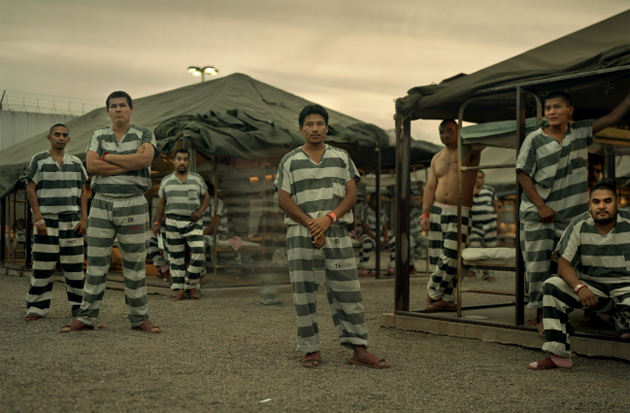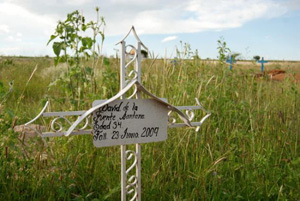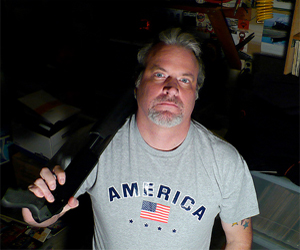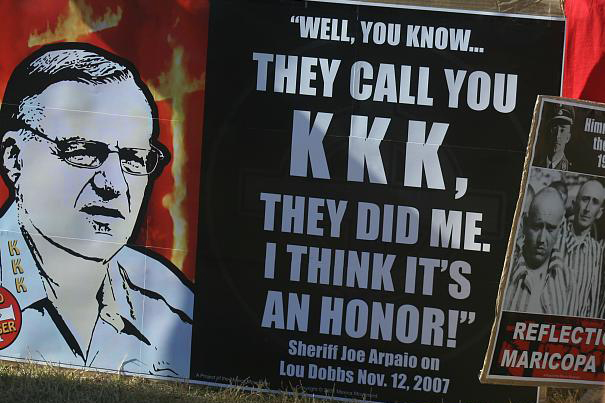
Undocumented Mexican immigrants in Sheriff Joe Arpaio's infamous Tent City.Jon Lowenstein/NOOR
Editors’ Note: Read our primer on Supreme Court oral arguments about Arizona’s strict anti-illegal immigration law, and check out our one-of-a-kind database of anti-immigration laws. Plus: See a related photo essay here.
David de la Fuente might still be alive if his pal David Salazar hadn’t been short on cash one day. Both men lived in Phoenix, where they’d settled after making their separate ways north from the Mexican farming village of Colonia Emilio Carranza many years earlier. Salazar and his family came across legally in 1974, while de la Fuente arrived during the 1990s, traversing the desert on foot to cross the border illegally near Nogales, Arizona. De la Fuente, a plumber, and Salazar, a delivery driver, eventually became good friends. Their families grew close, too, often spending weekends and holidays together.
But that all changed one morning in May 2009, when Salazar asked de la Fuente for a ride to the ATM. They hopped into de la Fuente’s green Nissan Maxima and drove to a nearby Wells Fargo. As they were about to turn into the parking lot, a Phoenix squad car driving behind them hit its flashers.
By Salazar’s account, officer Matthew Prutch asked de la Fuente for a driver’s license. When he produced a fake, Prutch had him step out of the car and handcuffed him. Salazar asked the officer whether he’d pulled them over because of their skin color; Prutch, he says, replied that he was just doing his job. (In his report [PDF], Prutch wrote that he ran the Nissan’s plates while following the car and found no driver’s license data associated with the registered owner. “He appeared to be a Hispanic male,” Prutch added, “and under reasonable suspicion I believe [sic] the driver to be driving with no valid license.”) Minutes later, another officer arrived and asked Salazar for his license, even though he hadn’t been at the wheel. Prutch then delivered de la Fuente to the police station for booking. From there, the 35-year-old was taken to Maricopa County Sherriff Joe Arpaio’s notorious Durango Jail, and charged with using a fake ID. A month later, he was dead.
Before SB 1070, the Arizona law that allows police officers to detain anyone they suspect might be in the country without papers, there was 287(g). That’s a 1996 amendment to the Immigration and Nationality Act under which the feds can deputize state and local law enforcement to capture and detain undocumented immigrants. Some 71 agencies in 26 states operate under 287(g) agreements—Arpaio signed up in 2007.
 When the Department of Homeland Security stripped Arpaio of the power to make arrests under 287(g), he held a press conference to make clear that he would continue to arrest people “that have not committed any crime other than being here illegally.”The man who calls himself “America’s toughest sheriff” has long had a knack for drawing media attention—reviving chain gangs (PDF), for instance, and humiliating county inmates by forcing them to don pink underwear (PDF). He grew obsessed with illegal immigration in 2005, when the state’s “coyote statute” took effect, making it a felony to smuggle people for profit anywhere in Arizona. As interpreted by then-county prosecutor Andrew Thomas, the law freed sheriff’s deputies to round up undocumented immigrants—after all, hadn’t these people conspired to smuggle themselves into Arizona? So Arpaio began sending out posses of citizens and lawmen to conduct immigration sweeps. “I’m not going to turn these people over to federal authorities so they can have a free ride back to Mexico,” he told the Washington Times. “I’ll give them a free ride to my jail.”
When the Department of Homeland Security stripped Arpaio of the power to make arrests under 287(g), he held a press conference to make clear that he would continue to arrest people “that have not committed any crime other than being here illegally.”The man who calls himself “America’s toughest sheriff” has long had a knack for drawing media attention—reviving chain gangs (PDF), for instance, and humiliating county inmates by forcing them to don pink underwear (PDF). He grew obsessed with illegal immigration in 2005, when the state’s “coyote statute” took effect, making it a felony to smuggle people for profit anywhere in Arizona. As interpreted by then-county prosecutor Andrew Thomas, the law freed sheriff’s deputies to round up undocumented immigrants—after all, hadn’t these people conspired to smuggle themselves into Arizona? So Arpaio began sending out posses of citizens and lawmen to conduct immigration sweeps. “I’m not going to turn these people over to federal authorities so they can have a free ride back to Mexico,” he told the Washington Times. “I’ll give them a free ride to my jail.”
It was Arpaio’s zeal that compelled me to spend five months on his home turf last year. I wanted to see firsthand how his tactics affected the Latino residents who make up 31 percent of the county’s population. I heard story after story—from citizens, legal immigrants, and undocumented residents alike—about encounters with deputies and cops determined to play Border Patrol. It got to the point where I raced home in a panic one morning after heading out for a jog without ID—what if a deputy, seeing a Latina running down the street, decided to haul me in?
Native Americans told me they were targeted because deputies mistook them for Latinos. Latinos told me of being stopped randomly on the street and shouted at—or worse—by officers demanding identification. Alex, a third-generation US citizen, was at a Circle K buying water while his parents waited outside. He ran out when he heard a group of Arpaio’s deputies yelling at them to produce their papers. Then, Alex said, they demanded to see his ID, too, explaining, “The law says everyone here has to be legal.” (Fearing retaliation, Alex asked that we not use his real name.)
Then there was Celia Alejandra Álvarez, who told me deputies broke her jaw during a raid at the landscaping company she worked for. Álvarez said she was denied adequate medical care during her three-month detention—a common complaint that has been the subject of hundreds of lawsuits against Arpaio. Even after surgery, she added, her jaw still isn’t back to normal—during our interview she paused periodically to readjust it. (In 2008, the National Commission on Correctional Health Care yanked (PDF) Maricopa County’s accreditation, saying its jails failed to meet national standards.)
Maurilio (who also feared giving his real name) is a construction worker who has lived in the United States without papers for 21 years, raising two kids who are US citizens. He said his family was camping at a lake over the Fourth of July weekend in 2008, when a fellow camper started yelling something about “too many Mexicans” and called the sheriff’s office. The deputies, Maurilio and his wife told me, threw him down in the presence of his six-year-old son and shoved his face into the ground. They then yanked his head up by his hair and pepper-sprayed him as they cuffed him. After a few weeks at Durango, he was deported—and immediately headed to the desert to walk back north.
To most anyone who even looks Latino in Maricopa County, the long arm of the sheriff seems inescapable. Indeed, Arpaio’s tactics have put his agency at the center of an ongoing civil rights investigation (PDF) by the Department of Justice. In the fall of 2009, without explanation, the Department of Homeland Security rescinded Arpaio’s authority to arrest people under section 287(g)—although deputies can still check the immigration status of people arriving at the jails. In anticipation of the crackdown, Arpaio held a press conference. “We have arrested 1,600 illegals that have not committed any crime other than being here illegally,” he boasted. “The secret is, we’re still going to do the same thing—we have the state laws, and by the way, we’ll still enforce the federal laws without the oversight, the policy, the restrictions that they put on us.”
When David de la Fuente arrived at Durango, his friends and family say, deputies immediately began grilling him about his immigration status. One of his sisters visited twice, as did Salazar. Each told me that de la Fuente was deteriorating quickly. The guards, he told them, kept dragging him back and forth between the prison yard (where temperatures reached 107 degrees) and the frigid jail—leaving him queasy and disoriented. He also complained of severe chest pains, but fearing the guards might retaliate, told his family not to press the authorities about his condition. Eventually, de la Fuente was hauled before a judge, who fined him and put him on probation for giving an alias to the police. After three weeks in custody, he was turned over to federal immigration authorities, who delivered him the next day to Nogales, Mexico, about 700 miles north of his hometown. By that time, he was gravely ill.
 David de la Fuente’s humble, hand-painted grave marker is adorned with a simple iron cross. Click here to see a photo essay from Aura Bogado’s trip to the de la Fuente family home in Zacatecas, Mexico.He arrived in Colonia Emilio Carranza three days later, stumbling and barely able to speak. His family got him to the hospital, where he was diagnosed with acute pneumonia. Based on the stage of his illness, the doctors determined that de la Fuente had contracted it about 15 days earlier—roughly a week into his jail stay—according to medical paperwork and an interview with the hospital director. The doctors did what they could, but de la Fuente was too far gone. His cousins and a sister stood vigil as he dwindled and eventually fell into a coma. He was pronounced dead on June 23—exactly four weeks after the traffic stop.
David de la Fuente’s humble, hand-painted grave marker is adorned with a simple iron cross. Click here to see a photo essay from Aura Bogado’s trip to the de la Fuente family home in Zacatecas, Mexico.He arrived in Colonia Emilio Carranza three days later, stumbling and barely able to speak. His family got him to the hospital, where he was diagnosed with acute pneumonia. Based on the stage of his illness, the doctors determined that de la Fuente had contracted it about 15 days earlier—roughly a week into his jail stay—according to medical paperwork and an interview with the hospital director. The doctors did what they could, but de la Fuente was too far gone. His cousins and a sister stood vigil as he dwindled and eventually fell into a coma. He was pronounced dead on June 23—exactly four weeks after the traffic stop.
We may never know what exactly happened to David de la Fuente inside Durango. To see his health records, family members would have to file a signed release and affidavit—something they are, not surprisingly, scared to do. What is clear is that Arpaio’s flavor of law enforcement will spread around the state if the ACLU (which filed suit in May 2010) fails to stop SB 1070 from taking effect. “The intent of the law was that it would be used disproportionately against people who have certain physical attributes,” notes Michael Wishnie, a professor at Yale Law School. “Police on the ground understand that and will act accordingly.”
This past September, during my visit to Colonia Emilio Carranza, Norberto Alvarado Santana said little as he showed me his cousin’s grave, in a humble cemetery adorned with plastic flowers and Virgen de Guadalupe figurines. A stout, reserved man, he measured his words cautiously before finally breaking the silence. “There’s a word for what happened to my cousin David,” he said. “It’s homicide.”
This story was supported by the Investigative Fund at the Nation Institute.















